Power empires
Power Empires is an example setting for Gempunks. [ Green ], [ Blue ], and [ Black ] things and gems of those colors are not present in it. The Projection psychic bloodline also does not exist.
The world of Power Empires is a spherical planet.
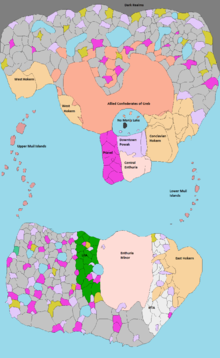
Ignatius the Lazy's map. (See Ignatius's Guide) |
Contents
Civilizations

 Enthuria: Tomb-Kings
Enthuria: Tomb-Kings
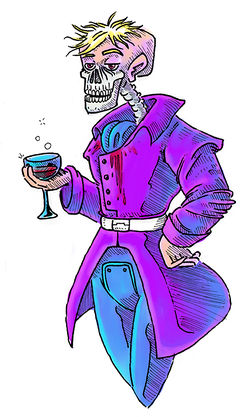
|
Founded by charismatic kings many centuries ago, this country continues to be led by those kings. Development of the raise dead spell has negated the need for hereditary rule, and essentially all major aristocrats have been dead for at least a hundred years. While this system leads to significant political stability, the occasional coup leads to the replacement of one ruling tomb-king by another. The accepted code of honor among nobles holds it as incredibly bad form to destroy or eat the body or soul of another noble, so most deposed tomb-kings lie dead in sarcophagi, ready to be revived and asked to lead again.
Farmers: Enthurian farmers are typically quite ignorant, intentionally kept in the dark by their nobility and priesthood. Aside from medical assistance, entertainment, preaching, and the occasional militarization, farmers are not overly micromanaged by their betters, and generally have a significant breadth of folk wisdom to draw on pertaining to farming and nature.
Nobility: Enthurian nobles are all male. Following an ancient royal decree, no noble would ever have children, and as such any person claiming to be a noble who does must be an imposter who deserves to die. The few new nobles are inducted into the ranks by being taken from their families before the age of 2, and raised by their adoptive father's servants and divine counselors.
Because the most important nobles have often been intermittently exposed to long periods of decay, nobles are usually very ashamed to have healthy skin, and often mask it with makeup, masks, or surgery.
Priesthood: The priesthood is a partially matrilineal hierarchy of spellcasters; only those priests who can cast raise dead are High Priests, and every priest who can cast raise dead is a High Priest. They have limited political power: essentially, their powers extend to giving religious advice or choosing who to return to life.
Paladins: The military branch of the priesthood, it is their divine mandate to root out and destroy evil wherever it lurks. This mainly consists of cleansing unsanctioned necromancers, putting down rebellions, and thwarting invasions from their neighbors.
The paladins have a distinct code of conduct: violating it is punishable by soul devouring. A few of the restrictions are provided here:
- They may not lie, even by omission, to a High Priest or the king.
- They may not cause harm to come, either directly or indirectly, to the true king of Enthuria.
- They may not strike one who lives due to the animating force of raise dead.
- They may not torture or poison the undead.
It is generally recognized that the most ruthlessly efficient paladins are those of the order Assassandra.

 Powak: Magocracy
Powak: Magocracy
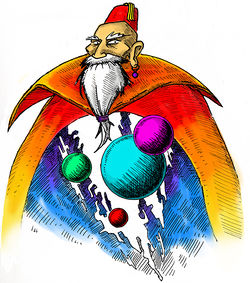
|
When the first Powaker mages asked for political rule and significant taxation in exchange for their support developing the agricultural and transportation bases of the country, there were few dissenters: being able to grow crops with 24 hour sunlight while living downtown was too much to pass up. Now, all important offices and businesses are held or run by mages, while most people toil away at dead-end jobs, the hope of one day being able to pass the entrance exams and get a time share of a gem just a distant dream.
Farmers: Living in the city despite working in the fields all day, Powaker farmers are still capable of easily keeping up with the latest innovations, politics, and popular culture. However, their obvious tans from being in the sun all day still mark them as ignorant country bumpkins by Powak standards. Easily more than half of the Powak are farmers or other outdoor laborers. Education is certainly not cheap, so despite typically having large numbers of children, seldom is more than one of them a scholar. Powaker farmers are typically fairly literate.
Mages: In order to vote or run a business, one must have at least passable knowledge of magic, and most Powaker academies pad out their arcane teaching with lessons on mathematics, geography, and history as well. Mages are frequently those farmer's children who were least fit for manual labor, so they are typically frail and weak.
Magisters: Mages who are successful enough to obtain full-time gem privileges become Magisters, and gain the right to run for public office. Since success of this nature cannot be trivially inherited, Magisters tend to be very ambitious people. For every clever Mage who achieves Magistrate status through magical prowess or innovation, there's one who achieved that status through cunning or political maneuvering, either by supporting a less socially savvy inventor or by stealing an invention.
Military: The powak make good use of gate to have the most mobile military in the world. Each powak city contains a military camp with a well-traveled gate-caster on call. The limited size of gate means that they cannot deploy particularly large vehicles or creatures, so their military is composed of elite soldiers, mages (who are subject to a limited form of draft), and plenty of conscripted foot soldiers. When siege weapons are required, they are typically built near the battlefield.

 Hokern Federation: Industrialists
Hokern Federation: Industrialists
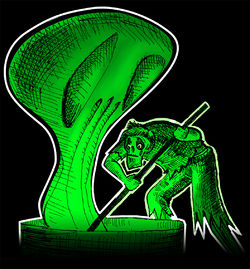
|
Tireless workers who can survive in toxic environments, rapidly fabricated structures, an ample supply of fire, and a plentiful supply of ores have given the Hokern a significant advantage in the metalworking and manufacturing fields. The governing body consists mainly of ambitious demagogues, greedy necromancers, and peasants who like oppressing more than being oppressed; The Hokern themselves call them glorious leaders, benevolent magi, and heroic troops, at least in public. Rather than waste any of their precious time on trivialities like health and safety, the Hokern work as hard as possible to improve the might of their empire.
What is the use of slaving away to increase one's might if not in order to use it? Needless to say, the Hokern frequently initiate wars the other side's well-publicized slights provoked.
The phrase "to each as they need, from each as they can provide" appears frequently on propaganda posters and in public speeches. However, not everyone has the same needs:
High-ranking government bureaucrats need a plentiful supply of good food and relaxation time in order to be in the right state of mind to lead their provinces or industries to success.
Intellectuals need the freedom for research, but also need to have their faith in the Hokernian way of life regularly reaffirmed lest they fall victim to the tantalizing yet ultimately empty ideals of foreign nations.
Soldiers need opportunities to show their bravery and courage by heroically risking their lives for the glory of Hokern. They also need the wholehearted support of the people at home, as doubt sullies their honor.
Laborers need to keep busy, as idleness among members of that class leads to self-destructive activity. They need a simple, wholesome life of stirring the smelting pots followed by a long afterlife of working in the poison-mines, or other equally invigorating tasks.

 Pranel: Thought Police
Pranel: Thought Police
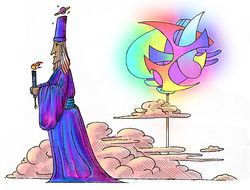
|
The Pranel, with their access to the gems relating to both mind and soul, are exceptionally well suited to study the nature of consciousness. To help them with their meditations, they build cities high in the sky to physically remove theirselves from earthly distractions. Although it is necessary to go down to earth in order to farm and trade, the upper class people are generally disdainful of such practices, and the majority of the priesthood never touches the ground. The Pranel priesthood use their considerable expertise in the nature of thought to keep the lower and middle classes in line, so peasants are typically happy, obedient, and utterly convinced that the Pranel are close to true enlightenment. Prolonged exposure to the outside world moderates this slightly.
Not every Pranel city has the same idea of the correct method to approach enlightenment, and the personality traits of a Pranel citizen depend more upon which city they come from than upon their own natural inclinations. While calm, duty, and happiness are the most popular routes, only a few years ago the Pranel city of rage was still standing.
In some Pranel towns, experimentation with instantiate perfect human is common, where each generation of legend-tier priests makes dozens or hundreds of perfect humans according to their best ideas of what an enlightened person would be like, then some of those perfect humans go on to learn to be legend-tier priests and repeat the cycle. One of the Pranel cities of Calm has a thousand people living there, all of them perfect people from a dozen different variations of ideas about what the ideally calm, level-headed person would be.

 Greb: Demon Hunters
Greb: Demon Hunters
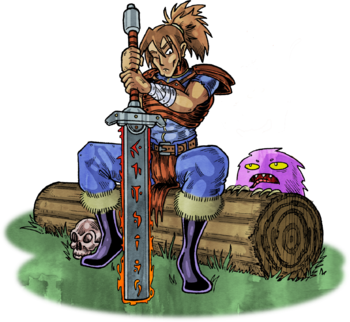
|
Flesh-eating, house burning, mind controlling mages gave the people of Greb no reason to appreciate the potential benefits of wizardry. Already tough and hardened by their lives on the edge of civilization, they were eventually reasonably successful at wiping out the casting members of their population, although spells like time skip mean that such people even from centuries long gone occasionally pop up here and there. Although they're not entirely happy with it, the people of Greb do use plenty of magic items in their battles with magekind.
Greb culture is a form of meritocracy founded mainly on skill in battle and hunting. The member of a Greb tribe who has proven theirself in battle against the greatest threats is usually the leader, and any great slayer of powerful wizards is welcomed almost universally by the Greb.
Those who show promise as hunters are afforded much respect and admiration, getting the choicest cuts of meat and the best domiciles, but they are also expected to go out and fight mages, unicorns, and dragons on a fairly regular basis.
Those who are too weak or cowardly to fight, or who have been taken captive by raiding parties in foreign lands, are the lowest members of Greb. Although this includes the finest craftspeople among the Greb, those who are not hunters find that the greatest benefit they receive is the relative safety of staying in a village that is only occasionally attacked by vengeful wizards and dragons.

 Muil: Nomads
Muil: Nomads
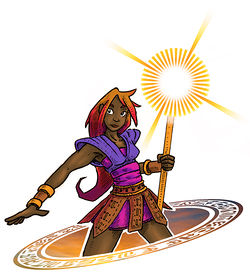
|
Living on the distant eastern and western equatorial islands of Muil is pleasant, but the islands lack many resources necessary for proper success. For this reason, some of the Muil choose to carry portals from Muil to distant lands in order to establish trade routes or bring raiding parties. These Muil nomads are generally well-respected for their bravery and dutifulness, but this respect seldom translates to truly impressive amounts of wealth or independence; most Muil nomads serve the leadership on their home islands, since it's hard to maintain true autonomy when your leader can pop by and tell you what to do every day.
Since the islands are not large enough to support unlimited population growth, occasionally groups of Muil will choose to live inside an extradimensional space, with the entry point(s) carried by nomads. Equipping a nomad who is holding the primary object entry point of such an extradimensional town with a Wand of Rewind protects the entire town from the worst problems with Rewind-based assaults.
The Muil serve a valuable role as traders between distant nations. Even near Powak territory, where their potentially even more efficient transportation networks are available, Muil competition prevents Powak tariffs from successfully skyrocketing. Muil seldom agree to pay tolls or tariffs imposed by others, or obey laws on contraband, and most of their violent conflicts with other peoples stem from such disagreements.
Terrains
While each terrain is described by a method for randomly generating a battlefield, after generating a few battlefields you (the DM) may be able to more quickly generate a map of much the same style without using the random generation technique.
Grassy Plateaus
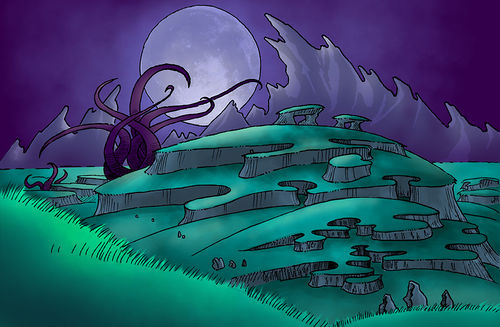
|
The land where Extradimensional Cephalopods lurk is a land of beautiful green fields, broken up into many flat cliff layers.
Generating a 200 x 200 meter map:
1d6 cliffs, with the first cliff spanning the map, and each further cliff stretching from a previous cliff or an edge to the edge or another cliff, whichever comes first.
One side of the cliff is lowered by 4d6 meters, with another 1d6 for every 6 rolled.
Each cliff has 1d6-3 (minimum 0) 30 to 90 degree turns in it.
1d6 ramps or landslides connect higher to lower ground
1d6-4 (minimum 0) rocky bridges, connecting two regions of equal height, if any such regions are present
1d6-4 (minimum 0) chasms spanning the map. The chasms are mostly 4d6 meters wide, and 7d6 meters deep from the lowest cliff regions they cross. Each chasm has 1d6-4 (minimum 0) spots of different width, 3d6 meters wide and 3d6 meters long.
1d6 points of interest, roll 2d6 for each one and consult this table:
| 2d6 Roll | Feature |
|---|---|
| 2, 3 | A small shrine |
| 4, 5 | A pond |
| 6 | A lower cliff area is filled with water, or a chasm is actually a river |
| 7 | A large boulder |
| 8 | A farm |
| 9 | A tower |
| 10 | A grove |
| 11,12 | A cave or pit |
The plateaus are frequently used as farmland by Powak and Pranel, and the Powak sometimes also situate their cities there.
Powak Metropolis
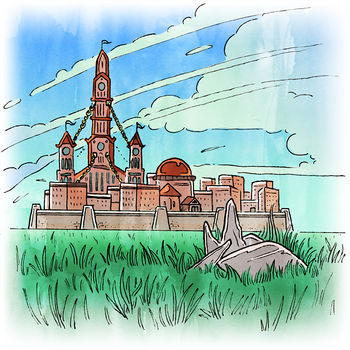
|
Powak Metropolises may be built of bone, stone, or wood, or sometimes even deep underground but the essential structure is the same.
Generating a 100 x 100 x 100 meter map:
Determine number of building stories (Each story is 4 meters high, or 3 underground): 1d6 + 5 is the lower bound. Each individual structure is 1d6 stories taller than that, and extends 1d6-3 (minimum 0) stories underground.
Divide into blocks:
- 1d6-3 (minimum 0) major streets, 20 meters wide
- 1d6 minor streets, 8 meters wide
- 2d6 alleys, 2 meters wide. Alleys go between two streets only, or dead-end.
Now that blocks have been generated, for each block, roll 2d6 on this table to determine the structure inside:
| 2d6 Roll | Feature |
|---|---|
| 2 | Boarded up and abandoned |
| 3 | Kinetic Energy Generator. Constantly moving chains span from this building to adjacent ones. |
| 4 | Arcane laboratory |
| 5-9 | Ordinary public building (apartments, shops, offices) |
| 10 | Slaughterhouse and/or grain silo linking to a farming village (via gate/portable hole) |
| 11 | Outpost linking to the main government building (via gate/portable hole) from which all of that service's operations originate: post office, police station, fire department, or public transit |
| 12 | Park (only 1 story) |
For each story above the first, there are 1d6-4 (minimum 0) sky bridges spanning from one building to another.
There are 1d6-1 spatial tunnels connecting different floors and potentially different structures; there must be a location from which it could have once been possible to see both ends of the tunnel.
There are 1d6-5 (minimum 0) (on a roll of 6, repeat) portals connecting from some well-protected or secret room to a far and distant land. Each one may be either a Gate or a portable hole.
For any given structure, the mechanism by which one travels to a different floor of that structure is determined by rolling 1d6 on the following table:
| 1d6 Roll | Method |
|---|---|
| 1, 2, 3 | Stairs |
| 4 | Elevator (Kinetic Energy Generator Powered). Powak Elevators are not complex enough to have a stopping mechanism; they simply travel upwards at a rate of 1 floor every round, then slide to the side and go down at the same rate. |
| 5 | Spatial tunnel from bottom to top floor, slides and staircases down. |
| 6 | Spatial tunnels between adjacent floors. |
Fossil Caves
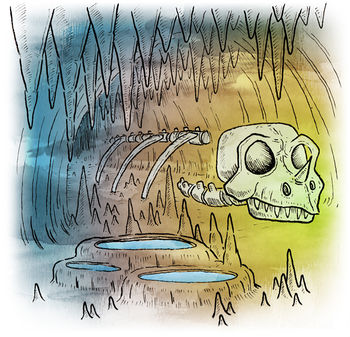
|
An excellent source of the fossils that many of the most powerful undead need to survive.
Generating a 100 x 100 x 100 meter map:
There are 2d6 large caves, distributed randomly. Caves are somewhat oval in shape, and 5d6 x 5d6 x 5d6 meters in size. Each large cave is filled with something, roll 1d6 on the following table to determine what:
| 1d6 Roll | Method |
|---|---|
| 1 | Half full of water |
| 2 | Completely full of water |
| 3, 4 | Air and walkable rock |
| 5, 6 | Air, but tunnels leading into or out of the cave connect to precarious ledge(s) along the side. |
1d6 tunnels connecting large caves to other large caves
1d6 tunnels connecting two other tunnels
1d6 dead end tunnels connected to large caves
1d6 dead end tunnels connected to tunnels
1d6 tunnels connecting large caves to the surface; unless the cave system is deeper than that, in which case it connects to higher-up tunnels.
1d6-1 tunnels connecting from large caves to outside the map, laterally or downwards
If characters frequently visit the caves for fossil harvesting, the vertical tunnels have ladders, and there's one more of each kind of tunnel except for the surface kind.
- Powaker caves have 1 fewer surface tunnel, and usually have a portable hole tunnel somewhere. If the cave structure has no surface tunnel, the portable hole is in a random large cave; otherwise, it is in either the lowest cave or on the surface.
- Hokernian caves are usually filled with poisonous gas, as mining is done by undead.
- Enthurian caves tend to be well-lit, respectfully decorated, and sometimes have stairs and paths instead of ladders.
Muil Island
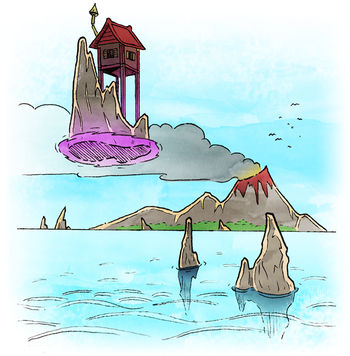
|
The Muil live on islands in distant oceans, using nomadic portal carriers to trade with other places.
Generating a 200 x 200 meter map:
If it's on a coast, draw a meandering coastline from one edge of the map to the other. The coastline is mostly sand, with 1d6 instances each of rocky sections (1d6+2 meters long) and cliff sections (2d6 meters long and 2d6 meters high)
The water contains 3d6-10 (minimum 0) small islands, each one 2d6 meters in diameter at the thickest part.
There are 1d6-5 (minimum 0) lava flows, 2d6 meters wide.
There are 1d6-4 (minimum 0) streams, 1d6 meters wide.
For the following natural features, roll twice if not on a coast:
- 1d6-1 sinkholes, 2d6 meters wide and 5d6 meters deep.
- 1d6-2 (minimum 0) groves of 3d6 meter tall trees, 23d6 meters long and 23d6 meters wide.
There are 3d6 structures on metal stilts (8 meters above ground). Roll 1d6 on the following table to determine their identities. Each building is rimmed by a 1 meter wooden walkway, and most buildings have ladders down to the ground.
| 1d6 Roll | Type |
|---|---|
| 1 | Tower: Ladder leads up another 3d6 meters to a viewing floor. Tower is 1d6 meters wide |
| 2, 3 | House: House is 2d6 meters wide x 2d6 meters long. For every roll of 8, extend one side out another 2d6 meters, repeating the process. Extensions of a side that's longer than the original length only extend the new portion of that side. |
| 4 | Tavern, town hall, or portal building (Portal building has a portable hole connecting to some far and distant land): 3d6 meters wide x 3d6 meters long. |
| 5 | Shop, blacksmith, or other crafting structure: 2d6 meters wide x 3d6 meters long. |
| 6 | Slaughterhouse, grain silo, or food curing structure: 3d6 meters wide x 3d6 meters long |
Every building tends to have 1d6-2 (minimum 0) bridges connecting it to other nearby buildings.
Hokern City
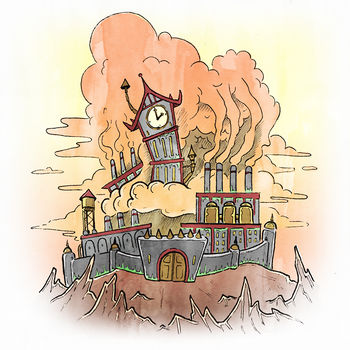
|
The Hokernians work hard for the glory of the Hokern people.
Generating a 200 x 200 meter map: Divide into blocks:
- 1d6-4 (minimum 0) Railroads. Each railroad contains 1d6 tracks, each track being 4 meters wide. On either side of a set of tracks, there are 2 meters of gravel, and possibly a fence. For every track, every 3d6 rounds a train comes rushing along the track at a rate of 300 meters per round. Pressing your ear to the rail (a Move Action) allows you to determine the number of rounds until the next train comes, so long as that number is less than your Auditory Perception +2.
- 1d6-4 (minimum 0) Major Streets, 20 meters wide
- 2d6 minor streets, 3.5 meters wide. Along one side of each minor street there is a Diseased Gutter, 0.5 meters wide. Falling prone in this gutter forces you to make a save against a disease that could thrive there. Likely diseases are: Bonewater, Necrotizing Fascinitis, The Hunger, or Black Death.
Now that blocks have been generated, roll 2d6 on this table to determine the contents inside:
| 2d6 Roll | Type |
|---|---|
| 2,3 | Tavern |
| 4 | Casino |
| 5-8 | Slums |
| 9 | Worker reanimation center or town hall |
| 10 | Convenience store |
| 11, 12 | Factory, filled with one or more of the following: conveyor belts passing beneath slicing or crushing devices; catwalks over large vats of molten metal or caustic fluids; explosives |
Pranel Sky City
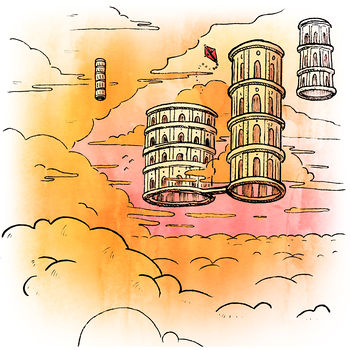
|
The Pranel feel that thinner air and distance from the earth allows one to distance oneself from worldly concerns. It also helps defend against invaders. Building the cities involves complicated use of share movement and gate, but once constructed, the entire city is locked to the earth by a single share movement spell.
Generating a 200 x 200 meter map:
Buildings are usually arranged to form the shape of some symbol or other:
- 10d6 minor buildings, 4 meters in radius. Minor buildings are things like shops, the houses of rich people, and shrines.
- 2d6 major buildings, 12 meters in radius. Major buildings are things like apartments and larger shrines
- 1d6-2 (minimum 0) very major buildings, 7d6 meters in radius. Very major buildings are things like lecture halls, temples, or portals to the surface
Around each building is a 1 meter walkway, and most buildings are connected by walkways to the three nearest other buildings.
Jagged Mountains
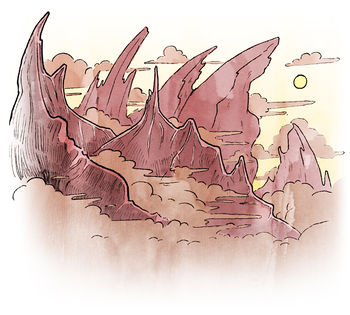
|
Jagged Mountains in places of strong white presence are an excellent place to find Fossil Caves. Jagged Mountains in Orange territory are popular roosting places for Dragons.
Generating a 200 x 200 meter map:
The entire map is set at a 60 degree slant. While it is possible to walk up or down the slant, it is difficult terrain, and being pushed down leads to rolling and bumping, dealing damage as per a fall of half the distance.
At lower parts of the mountain, one may find as many as 4000 trees in a map area of this size, while in the upper sections, it may be as few as 100.
The area also contains 2d6 points of interest. For each, roll 1d6 on the following table:
| 1d6 Roll | Type |
|---|---|
| 1 | Natural spring, with a small creek flowing down the mountain |
| 2, 3 | Sinkhole, 2d6 meters wide and 3d6 meters deep |
| 4 | Small shrine |
| 5 | Cave entrance |
| 6 | White - Death Rift, 3d6 meters long, leaking white light. Living creatures get -1 Toughness while within 5 meters of it, and are killed if they touch it. Undead creatures get +1 Toughness while within 5 meters of it, and can take a standard action to touch the rift and be healed for 1 HP.
Orange - Lava flow, going down the mountain. |
Paths may consist of simple beaten ground, zigzagging up the mountain, or steep staircases going straight up. While just as dangerous to be pushed down, the staircases and paths are not difficult terrain.